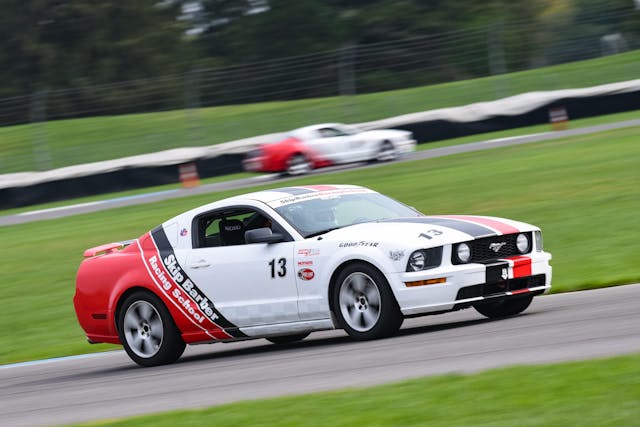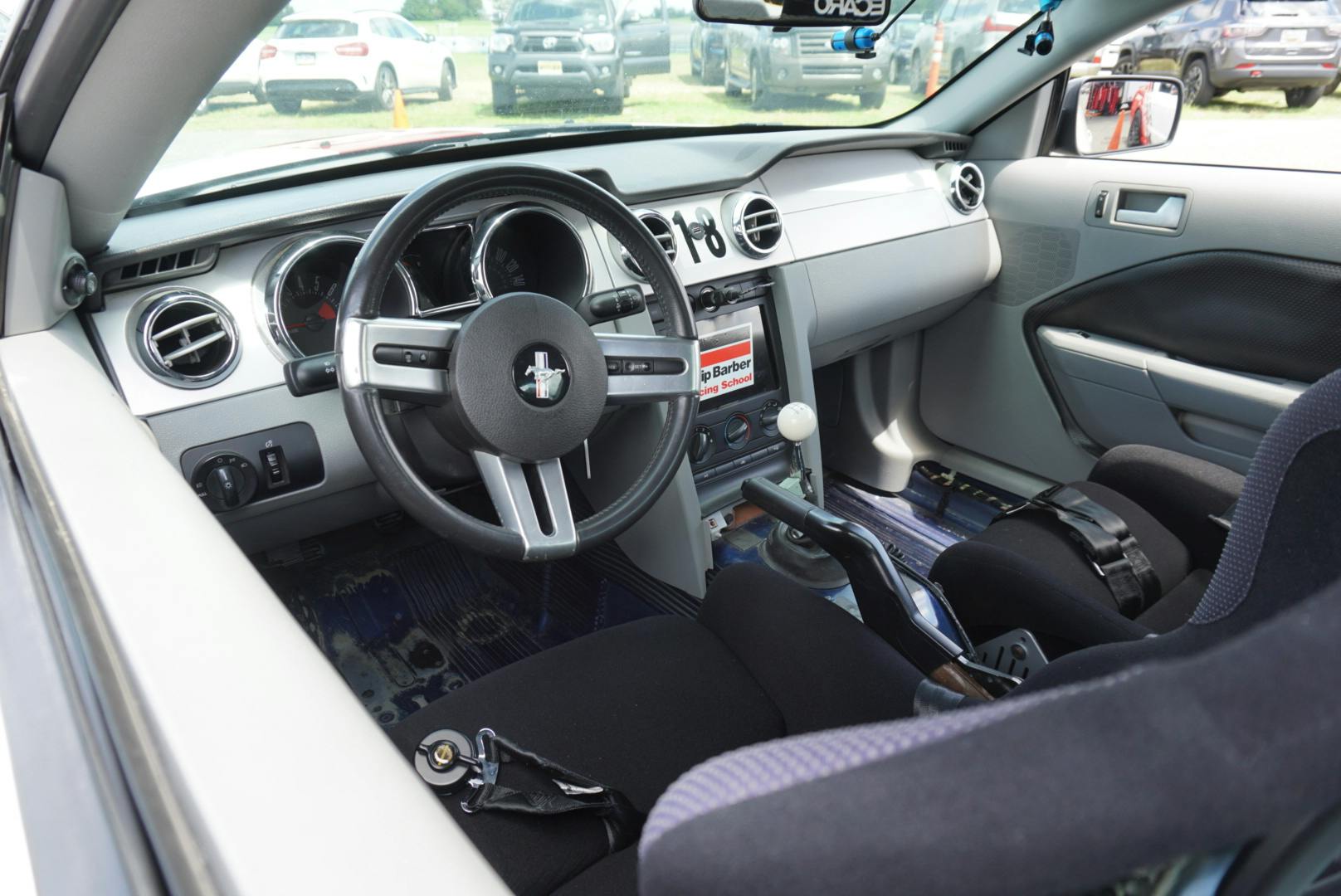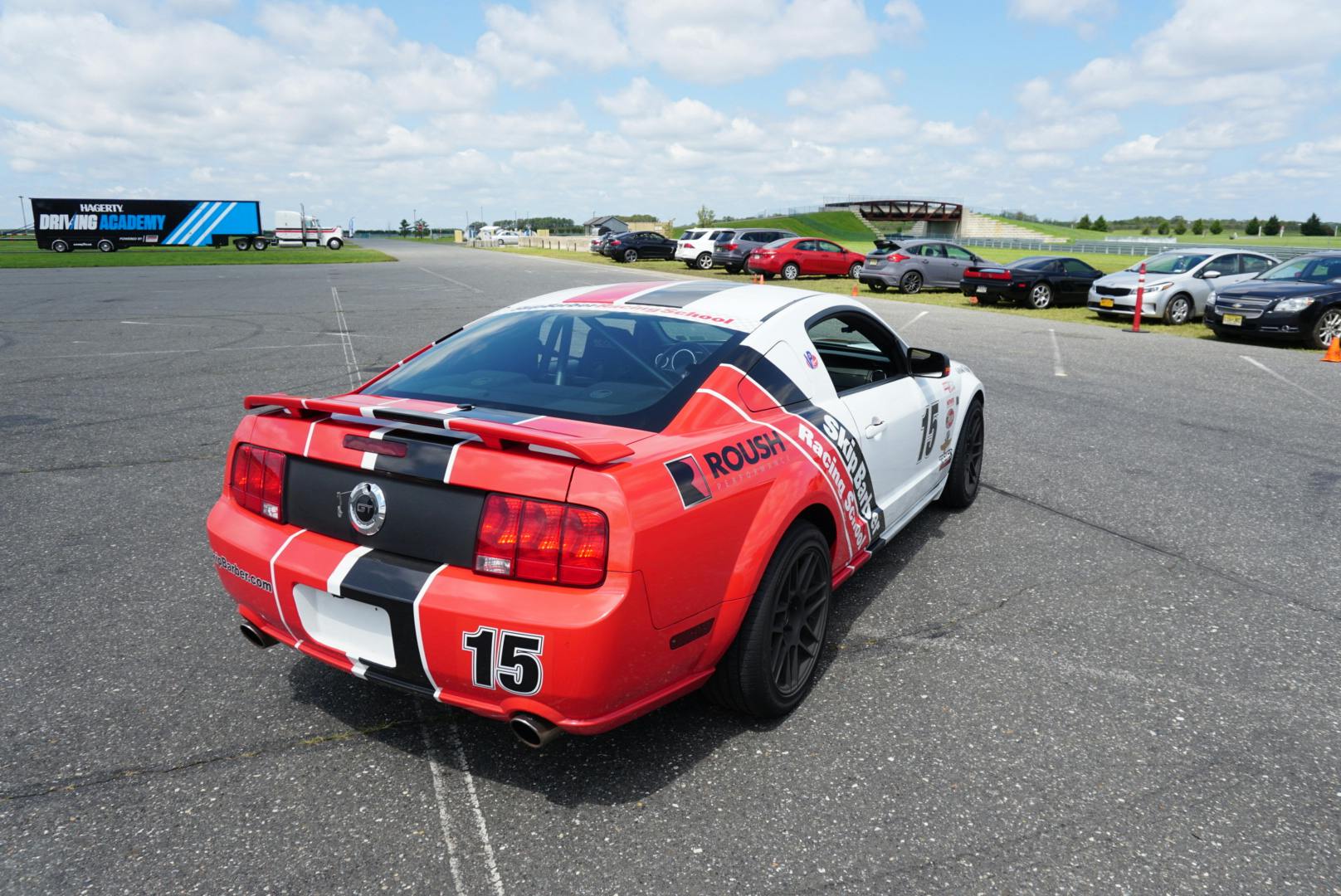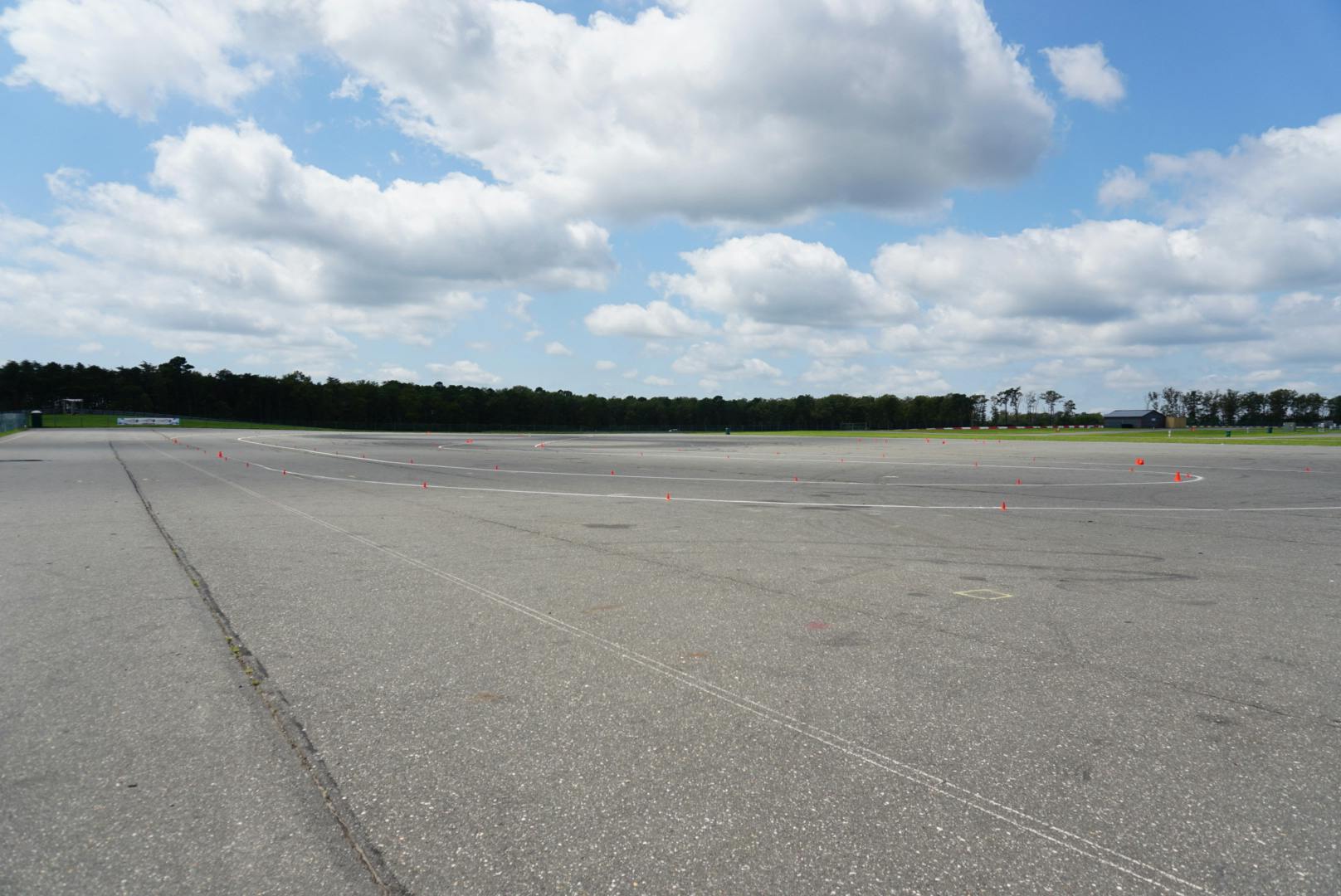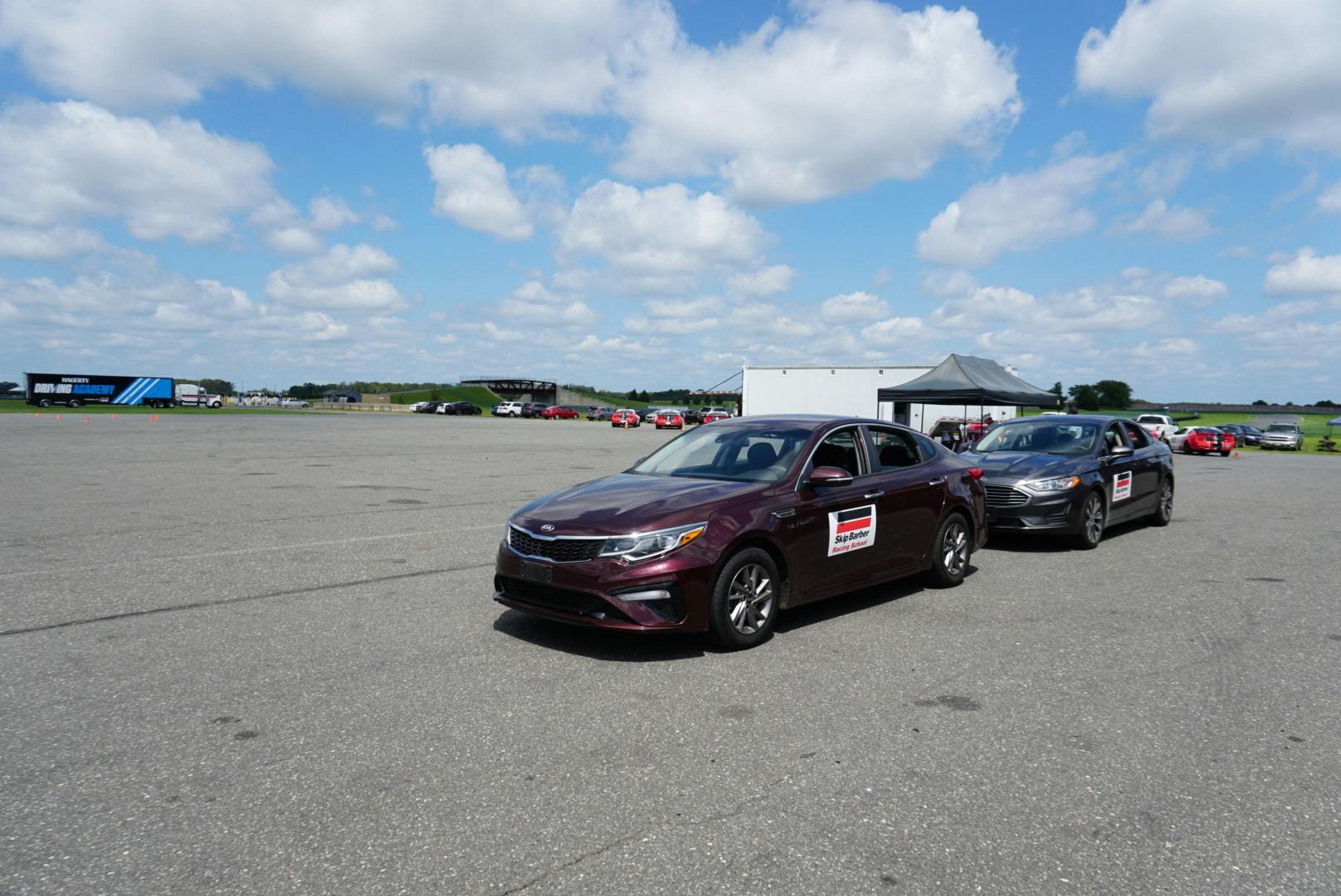Media | Articles
Skip Barber’s 3-day racing school is worth every minute
Education, whether in grad school or grade school, has a tendency to oscillate wildly between fun and drudgery. It takes the rare instructor, environment, and subject matter to make learning truly enjoyable and fulfilling in the moment. Stick-shift Mustangs on an open track have a way of helping, and Skip Barber Racing School is just such an exception.
Founded in 1975, Skip Barber Racing School has reached more than 300,000 students and has expanded its program repertoire to include a four-hour intro class, one- and three-day racing schools, and an advanced two-day program. Its red, black, and white-liveried fleet of Mustangs travels across the U.S. to tracks including Laguna Seca, VIR, Lime Rock Park, and even Indianapolis Motor Speedway. (It’s the first racing school ever allowed access to the Brickyard.) The instructors hail from every avenue of motorsports—the endurance circuit, the drag strip, Can-Am, World Challenge, and NASA—and beyond, including law enforcement and the stunt industry.
You won’t emerge from a three-day school with the skills of Josef Newgarden, Danica Patrick, Marco Andretti, or Juan Pablo Montoya, but you will have a blast, transform your driving, and be able to say that you share with these racers the hallowed status of Skip Barber alumni. The best part? Once you’ve picked a school and a date, all you need is a pair of closed-toed shoes and a basic understanding of a manual gearbox. The school takes care of everything else, from catering lunch to providing a helmet. They’ll even swap out your Mustang’s demolished brake pads for fresh ones. Naturally, track access and professional coaching and a fully-maintained racecar come at a price; our three-day school at New Jersey Motorsports Park this August was $5795, but the figure varies based on venue.
The programs attract a wide range of students. My class included a Trans-Am mechanic anticipating retirement, a professional stuntman who wanted to broaden his repertoire beyond drifting, and a weekend spec Miata racer looking to hone his craft. However, your racing background—or lack thereof—doesn’t matter; the instructors are adept at meeting each student at their particular skill level.
Our principle instructors at NJMP were Mike Stillwagon and Eric Powell, assisted by a dozen or more staff members and all connected via walkie-talkie. Stillwagon, general manager and lead driving instructor, started the programming promptly at 8 a.m. He’s spent more time behind the wheel of race cars, pace cars, and development cars than most have spent commuting to work, and he’s logged hundreds of hours at NJMP in particular. Powell, who’s the chief administrative instructor, boasts over a decade of experience driving stunts for Disney in addition to racing in karts, formula cars, and multiple classes in World Challenge. (He’s also perhaps the world’s only advocate for “finesseful” driving. More on that later.) The two instructors rib each other constantly, but they’re no-nonsense when it comes to safety and car control.
Marketplace
Buy and sell classics with confidence
Skip Barber’s three-day racing school involves much more than seat time in Mustangs and exposure to wise racing sages. The staff has had 45 years to create and fine-tune a curriculum that uses visual, auditory, and tactile instruction. Throughout the program, we move from classroom time to instructor demos and lead-follow sessions with clockwork-like efficiency. There’s never a clueless moment. Stillwagon and Powell make sure everyone knows exactly what to expect before they even reach for a helmet.
Though you might imagine this intensity turns the whole program into a tightly controlled cram session, it’s actually freeing; students can relax and absorb every bit of information without worrying about a single scheduling detail. You’re spending as much time as possible either in the race cars or learning how to be a better driver on the track, which is why you made the trip in the first place, right?
What will you be driving? Unless you’ve opted for one of the open-wheel schools, you’ll be strapped very tightly indeed into a stripped and race-prepped Mustang GT. A 4.6-liter, 325-hp V-8 sits under the hood. It breathes through a Ford Racing intake and is mated to a Tremec five-speed manual. Power goes to the rear wheels via a 4.1 Torsen differential which, according to Stillwagon, makes the Mustang feel more like a 360-hp car. A Ford Racing coilover suspension and StopTech brakes help handle corners. The entire time you’ll be ensconced in snug Recaro buckets and treated to a soundtrack courtesy of Ford Racing-tuned headers and a Borla exhaust. Jongbloed wheels wear Goodyear Eagle F1 tires to complete the Mustang’s street-to-track transformation.

Our August session took us to the 1.9-mile Lightning circuit at New Jersey Motorsports Park. Stillwagon knows this track intimately, and during our chauffeured laps in a van, it showed; he pointed out pavement repairs that we could use as reference points to stay on the racing line or individual stacks of tires to demarcate braking zones. He advised us to use the bridge before turn seven (a near-90 degree lefthander and the slowest corner on track) as an initial braking point, but cautioned us not to trust the bridge’s shadow. That moves.
Learning the corners and jumping in a race car does not make you a better driver right out of the gate. The instructors wanted to ensure we knew the “why” behind every input on the track, and so the first day began with the basics: weight transfer, contact patches, steering load, the fundamental physics of grip and turn radius. “It’s all about finesse,” Powell repeated again and again, reminding us that brute speed did not equate to low lap times. Gesturing like an orchestra conductor, he’d talk us through a videoed lap: “Squeeze the throttle. Finesse the brakes.”
Before we hit track in the first lead-follow session, we alternated between the skidpad and the autocross course to learn braking technique and spin recovery. Only after these exercises—and after everyone could chant on command “if you spin, two feet in!”—did we zip up our race suits, pull on helmets, and head for the Mustangs.
One’s first experience in a race car can be overstimulating, not to mention mildly claustrophobic, and the instructors reminded us that breathing is important. Straightaways can be a great time to take a calming inhale. Even once we got on track in the Mustangs, the instructors gave us manageable doses of information. As we trailed behind the instructor cars in clumps of three or four, we simply focused on learning the racing line and braking zones and keeping our eyes up for signals from corner workers. During the first few sessions, we didn’t even have to worry about downshifting and ran the whole course in fourth gear.
We graduated from lead-follow sessions to stop-box sessions, in which cones framed two “lanes” on track where we would pause to receive radioed feedback or leave breathing room between cars.
The most technically intimidating technique, heel-and-toe downshifting, showcased the school’s well-tuned sense of pacing and its ability to adapt to individual learning curves. Downshifting was a primary focus of the second day and started with a classroom session. Stillwagon first explained “why” and the “when” of downshifting, listing the sequence of movements while connecting them to what actually occurred in in the car’s drivetrain. While watching several video clips, both in slow motion and in real time, we learned how trailing clutch oversteer could provoke “the quickest spin in racing,” according to Stillwagon. Imagining an unrecoverable spin could provoke nerves in first-timers, but Stillwagon welcomed any and all questions: “The only stupid question is the one not asked.”
From the classroom, we crowded around the open door of a Mustang to peer into the footwell for a static demonstration. Then we each hopped in a car, an instructor opposite us, and prodded the pedals ourselves. Next we turned the key and ran through a short loop from pit road to the front straight and back, downshifting at each end. Seated beside us, the instructors gave us immediate and constant feedback, noting whether our blip was sufficiently aggressive or our pedal input too abrupt. Then the instructors swapped cars, and we ran the exercise with a different staff member for another coaching perspective. Even when my nerves got the better of me, making my inputs too jerky, the instructor wasn’t flustered; he simply told me to pull off to the side of pit row and turn off the car. We ran through the process while stationary and tweaked my foot placement on the brake pedal. A deep breath and an encouraging comment later, we were back on track and I was getting the hang of things. Only after the demos and drills did the staff let us loose for stop-box session; even then, we only had to worry about a single downshift before turn seven.
As an SCCA accredited professional driver school program, Skip Barber’s three day program taught proper passing technique, the entire range and significance of flags, and standard procedure for how races start and restart. You’ll walk out of the school not only with newfound confidence in your car control skills, but also with all the seat time you need to apply for your SCCA novice permit. Even if you don’t immediately apply and register for an SCCA event—maybe you race karts instead—the instructors encourage you to reinforce your newly acquired skills as soon as possible. A surprising amount of techniques can be practiced safely on the road, especially if you drive a stick-shift: smooth pedal inputs, keen awareness of weight transfer, and, in worst-case scenarios, skid recovery.
Skip Barber’s three-day program is efficient and packed with professional instruction on track, but the itinerary alone fails to capture the full experience. The Skip Barber staff has developed an all-inclusive program that’s both constructive for experienced racers and welcoming to first-timers. Competition and lap times simply don’t come into the picture; you’ll only discover your times once you purchase and download your in-car footage (captured across all three days). The instructors don’t simply love racing; they are genuinely passionate about teaching, and they’re excellent at it, both in a group and in one-on-one interactions. Every minute feels worth it.
Having fun and being safe are the most important things, and Skip Barber Racing School provides the ideal conditions for each. Still think education is a slog? This academy of speed begs to differ.
For a glimpse of in-car action during the three-day racing school, check out this video. Students’ first stints on-track in the Mustangs are kept to a very conservative speed. Subsequent sessions involve a threshold braking exercise and stop-box sessions with lap-by-lap feedback. The last day, everyone works together to practice race starts and restarts. The final afternoon, students put together everything they’ve learned in open-lapping sessions with strict passing zones.
